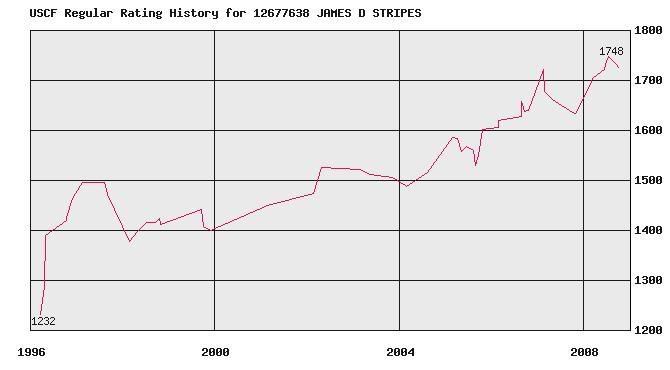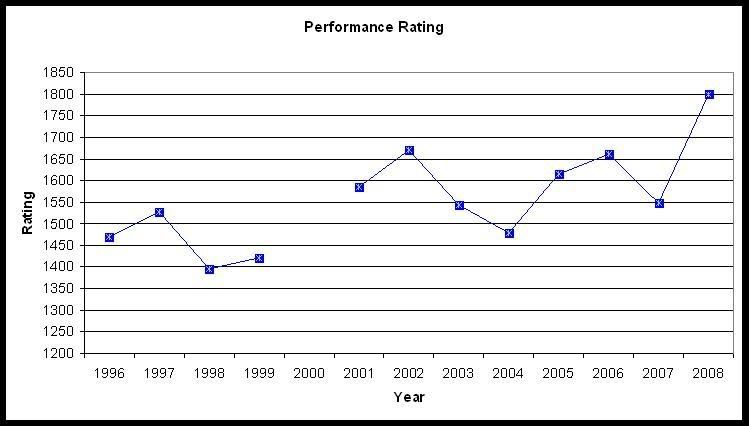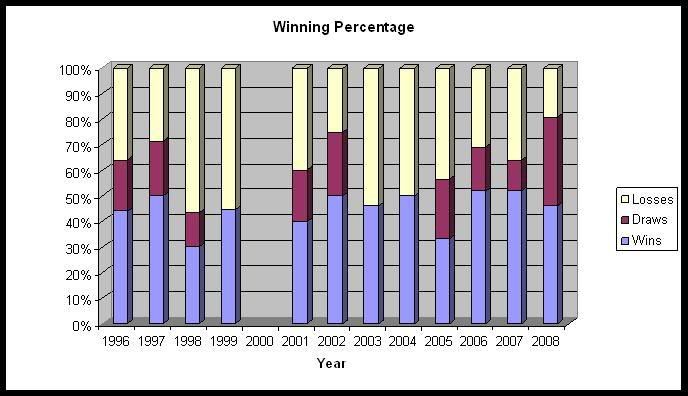
This graph shows the ups and downs of my improvement since I began playing in USCF rated events in 1996. Since then, I've played an average of seventeen standard rated games per year. The average number is atypical--most years I've played either a half-dozen or two dozen. The active years also have included several quick events. I played twenty-five or more standard rated games in 1996, 1998, and every year 2005-2008. In 2000 I played a few email games, two thousand online games, and started coaching elementary age youth, but did not play any OTB tournaments. My online chess activity peaked in 2003 during a steady decline in OTB performance.
This decline is clearly evident in a graph showing my average annual performance rating.

In the summer of 2005, I took lessons from a young Master. I started that year at 1516, ten down from my peak of two years earlier, and became ambitious when I jumped to 1586 after the first event of the year. Through the spring and summer I declined steadily to 1530, then in two fall events jumped up to 1601. I ended the year with ten wins, seven draws, thirteen losses, and an overall performance rating of 1615.
After crossing over 1600, I have not dropped back down below that mark. Rather, I continued a steady climb through 2006 to 1722 and then suffered a brief setback in 2007. In that year I played in six standard events and five quick--my greatest level of activity. Consequently, my standing in the local grand prix was near the top. I was on the cusp of qualifying for the City Championship Contenders tournament when I had to miss a mid-summer tournament due to work obligations. A youth player edged me out for the last spot, and there was no disruption of my fishing trip with some friends from graduate school.
I played in fewer events quick events through fall 2007 and spring 2008 and had not set the Contenders tourney as a goal, but qualified nonetheless (despite fewer grand prix points than the previous year). Then I won the Contenders tournament and became the challenger in the Spokane City Championship. I stepped up my preparation for this four game match against a FIDE master, and managed a draw in the third game. Game four went unplayed because the champion had successfully defended his title, but I took some rating points from him and peaked at 1748.
In the Eastern Washington Open in late September, I played poorly, but managed to avoid losses in my winless performance. Now, halfway through the fall club championship I have two wins and a bye (work conflict again) and face the top seed in round four. At this point in 2008 I have twelve wins, nine draws, five losses, and an overall performance rating of 1800.
I've never succeeded in getting my wins over 50%, but increasing the number of draws this year cut my losses to approximately 20%, as is evident in the next graph.

My present goal is to achieve a standard rating over 1800 by the end of the 2010 Collyer Memorial Tournament.














Why such a long term goal? Why not a rating over 1800 at august 2009?
ReplyDeleteSpring 2009 is one of those birthdays that everyone counts, so it is a logical time to mark certain achievements. 2008-2009 is also a busy year for me for chess organizing--I'm the principal organizer of the 2009 Washington State Elementary Chess Championship.
ReplyDeleteGetting over 1800 in Spokane requires 1) trips to tournaments in other cities (my youth chess coaching and organizing takes precedence over these trips at present), 2) playing well at the Collyer Memorial--our strongest annual event--because it attracts out of town talent from whom locals can steal rating points (I'm giving myself two more of this event to reach my goal), or 3) beating everyone at club (I lost to an expert last night, but gave him another scare).
As when I crossed 1600, my goal of getting over 1800 is not a temporary peak in the graph, but a new plateau. I am methodically building my skills so that once I'm an A player, I will remain so until I make it into the expert class.
Scholastic chess organizing is a very time consuming thing that definitely takes away from study time. Your peaks and valleys are typical of the improving player. It's also difficult when you're in an area where you don't get enough varied or higher rated competition. Here in NY we don't have that problem. Though I will be heading your way in November for the Washington Class Championships for a change of scenery.
ReplyDeleteHow did you extract the graphs from uschess.org and post those graphs on your blog? My blog is www.diamondbackchess.blogspot.com and I would to extract the chart and post it in my blog for one player. www.diamondbackchess.blogspot.com
ReplyDeleteOnly the first graph is from the USCF website. I created the other two with Excel.
ReplyDeleteTo get the USCF graph, I right clicked on it and saved as image file on my computer. Then I uploaded it and the other graphs to an image hosting service--I use photobucket, but there are many others. Photobucket can generate an link for embedding, which blogger then makes simple--just use the photo icon when you are creating a post.